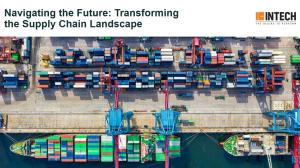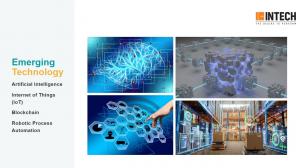Navigating the Future: Transforming the Supply Chain Landscape
The Current Landscape
Before delving into the strategies for shaping the future, it's essential to understand the existing challenges within the supply chain. As it stands, supply chains are often characterized by complexities, inefficiencies, and a lack of real-time visibility. Traditional models struggle to adapt to the dynamic demands of today's global market, leading to delays, increased costs, and suboptimal performance.
Complexity and Inefficiency
Global supply chains involve numerous stakeholders, intricate networks, and a myriad of variables. Coordinating the movement of goods from manufacturers to distributors to retailers demands a high level of synchronization. Yet, many supply chain processes still rely on manual inputs and outdated technologies, contributing to delays and errors.
Lack of Visibility
One of the fundamental challenges in supply chain management is the lack of end-to-end visibility. Information silos and a fragmented approach to data create blind spots, making it difficult for stakeholders to track the journey of products in real time. This lack of visibility not only hampers decision-making but also leaves room for inefficiencies and vulnerabilities.
Embracing Technology: The Building Blocks of the Future
To bridge the gap between the current state of supply chain management and the envisioned future, organizations must leverage cutting-edge technologies. Several key technologies stand out as the building blocks for shaping the future of supply chains.
1. Artificial Intelligence (AI) and Machine Learning (ML)
AI and ML have the potential to revolutionize supply chain operations by introducing predictive analytics, demand forecasting, and autonomous decision-making. By analyzing historical data and identifying patterns, AI can optimize inventory management, enhance demand planning, and streamline logistics, ultimately reducing costs and improving efficiency.
2. Internet of Things (IoT)
The IoT enables the creation of a connected supply chain ecosystem. Smart sensors and devices can be embedded throughout the supply chain, providing real-time data on the location, condition, and status of goods. This level of visibility enhances traceability, reduces the risk of losses, and allows for proactive decision-making in response to unexpected events.
3. Blockchain Technology
Blockchain introduces transparency, security, and traceability to the supply chain. By creating an immutable ledger of transactions, blockchain technology ensures that every step in the supply chain is documented and verifiable. This not only reduces the risk of fraud but also enhances trust among stakeholders.
4. Robotics and Automation
The integration of robotics and automation into supply chain processes can significantly improve efficiency and accuracy. From automated warehouses to autonomous vehicles for last-mile delivery, robotics minimizes manual labor, accelerates processes, and reduces the likelihood of errors.
Overcoming Challenges: Strategies for Implementation
While the potential of these technologies is undeniable, implementing them successfully requires a strategic approach. Overcoming challenges and ensuring a smooth transition to the future supply chain necessitates the following strategies:
1. Investment in Talent and Training
The successful adoption of advanced technologies begins with a skilled workforce. Organizations must invest in training programs to upskill their employees and foster a culture of innovation. This not only ensures that the workforce is equipped to handle new technologies but also encourages a mindset of continuous improvement.
2. Collaboration and Integration
A fragmented supply chain cannot fully harness the benefits of emerging technologies. Collaboration among stakeholders, including manufacturers, distributors, and logistics providers, is crucial. Integration of systems and data-sharing platforms facilitates seamless communication and coordination, enabling a more responsive and agile supply chain.
3. Data Security and Privacy
As supply chains become more connected, the importance of data security and privacy cannot be overstated. Implementing robust cybersecurity measures and ensuring compliance with data protection regulations are paramount. Building trust among stakeholders requires a commitment to safeguarding sensitive information throughout the supply chain.
4. Pilot Programs and Iterative Implementation
Rather than attempting a full-scale overhaul, organizations can mitigate risks by implementing pilot programs. Testing new technologies on a smaller scale allows for the identification of challenges and refinement of strategies before widespread adoption. An iterative approach enables organizations to learn from initial experiences and continuously optimize their supply chain processes.
The Road Ahead: A Collaborative Effort
Shaping the future of the supply chain is not the sole responsibility of any single entity. It requires a collaborative effort involving governments, industry leaders, technology providers, and academia. Regulatory frameworks must evolve to accommodate the use of emerging technologies, and incentives for innovation should be created to encourage widespread adoption.
Government Support and Regulation
Governments play a pivotal role in creating an environment conducive to the adoption of futuristic supply chain technologies. This includes providing regulatory frameworks that address the challenges and risks associated with AI, IoT, and blockchain. Incentives, such as tax breaks for companies investing in technology upgrades, can further accelerate the transition.
Industry Standards and Best Practices
Establishing industry-wide standards and best practices is essential for creating a cohesive and interoperable supply chain ecosystem. Collaboration among industry players can lead to the development of guidelines that promote the seamless integration of technologies and ensure a standardized approach to data sharing and security.
Conclusion
The future of the supply chain holds the promise of increased efficiency, reduced costs, and enhanced sustainability. However, realizing this future requires a concerted effort to overcome existing challenges and embrace transformative technologies. By investing in talent, fostering collaboration, addressing security concerns, and adopting an iterative approach, organizations can pave the way for a supply chain that is not just futuristic in theory but a tangible reality. The road ahead is a journey of collaboration, innovation, and continuous improvement—a journey that holds the key to unlocking the full potential of the future supply chain.
Harpalsinh Vala
INTECH Creative Services Pvt. Ltd.
+91 99044 77776
email us here
Visit us on social media:
Facebook
Twitter
LinkedIn
Instagram
YouTube
Legal Disclaimer:
EIN Presswire provides this news content "as is" without warranty of any kind. We do not accept any responsibility or liability for the accuracy, content, images, videos, licenses, completeness, legality, or reliability of the information contained in this article. If you have any complaints or copyright issues related to this article, kindly contact the author above.


